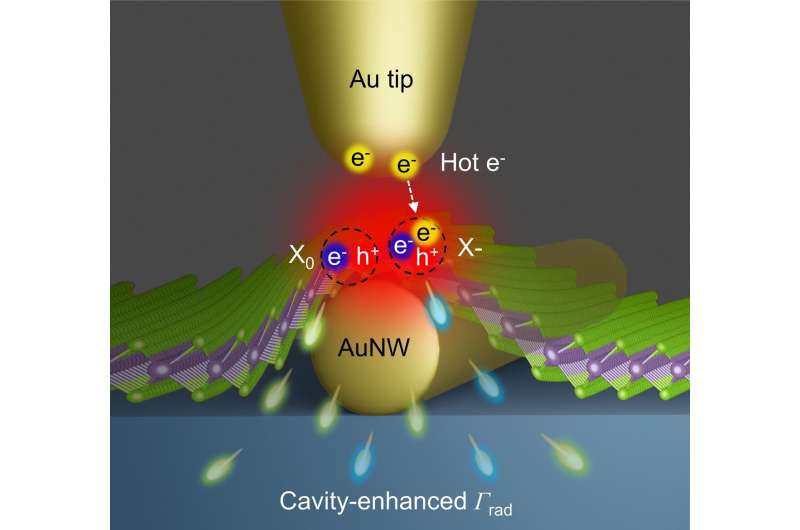
In a significant advancement for next-generation semiconductors, a collaborative research team has made groundbreaking discoveries in the field of two-dimensional (2D) semiconductors.
Their findings, published in Nano Letters, shed light on the generation and control of trions, providing valuable insights into the optical properties of these materials.
2D semiconductors, known for their exceptional light characteristics per unit volume with high flexibility due to their atomic layer thickness, hold immense potential for applications in areas such as advanced flexible devices, nano photonics, and solar cells.
The research team focused on harnessing the optical properties of 2D semiconductors, particularly the generation and recombination processes of electron-hole pairs, to develop light-emitting devices and optical applications.
To actively control the interaction of excitons and trions and analyze real-time luminous properties, the team developed their own probe-enhanced resonant spectroscopy system based on gold nanowires. By combining a single layer of MoSe2, a 2D semiconductor, with gold nanowires and a probe-enhanced resonance spectroscopy system, the researchers created a composite structure and a powerful analysis platform. Through this, they succeeded in identifying the principle of generating trions, which had not been known before.
The researchers discovered that the multipolar mode of electric charge plays a significant role in inducing the conversion of excitons to trions in 2D semiconductors. With the probe-enhanced resonance spectroscopy system, they achieved real-time analysis of nano-light properties with an exceptional spatial resolution of approximately 10 nm, surpassing the limit of light diffraction. This enabled the identification of the principle behind trion generation and the development of reversible active control over the exciton–trion conversion.
Moreover, the gold probe acted as an antenna, focusing light on a nano-sized area and generating high-energy thermocrons. The electrons generated by this process were then injected into the 2D semiconductor, further enhancing the control over trion generation. This breakthrough led to the proposal of a novel “nano active control platform,” enabling real-time, ultra-high-resolution control over the state of matter, surpassing traditional measuring equipment.
Mingu Kang, the first author of the study, stated, “Not only have we successfully controlled excitons and trions, but we have also identified the underlying principles governing their interaction with plasmons and thermotrons.” He further added, “We believe our research will present a significant breakthrough for researchers in fields utilizing excitons and trions, such as solar cells and photoelectric integrated circuits.”
The research team was led by Professor Kyoung-Duck Park and Mingu Kang in the Department of Physics at POSTECH, Professor Yong Doug Suh in the Department of Chemistry at UNIST, who concurrently holds the position of Associate Director at the IBS Center for Multidimensional Carbon Materials (CMCM), and Professor Hyun Seok Lee in the Department of Physics at Chungbuk National University.
More information:
Mingu Kang et al, Nanoscale Manipulation of Exciton–Trion Interconversion in a MoSe2 Monolayer via Tip-Enhanced Cavity-Spectroscopy, Nano Letters (2023). DOI: 10.1021/acs.nanolett.3c03920
Provided by
Ulsan National Institute of Science and Technology

READ MORE
From waste to clean water: Tiny carbon particles can do the job
Credit: Pixabay/CC0 Public Domain Many futuristic novels and films have explored what the world might [...]
How Did Plants Develop Photosynthesis?
Mark Zibert / Vaughan Hannigan When the last Apollo mission was on its way to [...]
Unveiling the Ingenious Invention: The Electric Pen
Thomas Edison’s electric pen was a forerunner to today’s electric tattoo machines. Samuel O’Reilly saw [...]
Researchers demonstrate graphene-based nanoelectromechanical periodic array with tunable frequency
NEMPA device and electrically tunable resonance modes. Credit: ZHANG Qinghang Phononic crystals (PnCs) are artificial [...]
The Race to Save Florida’s Manatees
A SeaWorld team prepares to release a rescued manatee. SeaWorld In May 2022, Stacy DiRocco, [...]
Opossums: So Darn Ugly They’re Adorable
A baby Virginia opossum (Didelphis virginiana). Don’t hate him because he’s beautiful. Diana Haronis/Getty Images [...]
Nano-thin printing of electronics hardware could slash costs
How the process worked. Credit: Mohammad Ghasemian and co-authors. Engineering researchers have developed a 2D [...]
Planets Around Other Stars Are Hot Hot Hot
Visionary astronomers such as Frank Drake and the late Carl Sagan, and philosophers centuries before [...]